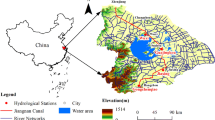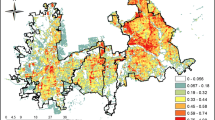Abstract
The characteristics of urban pluvial flooding are altering all over the world due to environmental change. In this paper, generalized additive models for location, scale and shape (GAMLSS) was employed to analyze nonstationary frequency of extreme precipitation at subdaily scale. Nonstationary precipitation return periods were estimated using the expected waiting time (EWT) interpretation. A model coupling SWMM and MIKE21 was established, and calibrated and verified by three historical urban floods. Then, it was utilized to simulate urban floods under stationary and nonstationary rainfall conditions with different return periods. The simulated results illustrated that rainfall depth under nonstationarity was greater than that of stationarity when return period was less than 10 years, but the results reversed when the return period was over 20 years. The main variation of rainfall depth occurred within 6 h. The deviation of the maximum water depth was less than 10% for five return levels, and the difference in the longest inundation lengths was 1.2 h for 50-year return period under two assumptions. It may indicate that slight differences of urban flooding were detected between stationary and nonstationary conditions in the study region, which suggested a further study about urban flood under nonstationarity.










Similar content being viewed by others
References
Akaike H (1974) A new look at the statistical model identification. IEEE Trans Autom Control 19(6):716–723
Babu MT, Vethamony P, Desa E (2005) Modelling tide-driven currents and residual eddies in the Gulf of Kachchh and their seasonal variability a marine environmental planning perspective. Ecol Model 184(2–4):299–312
Bermúdez M, Ntegeka V, Wolfs V, Willems P (2018) Development and comparison of two fast surrogate models for urban pluvial flood simulations. Water Resour Manag 32(8):2801–2815
Bisht DS, Chatterjee C, Kalakoti S, Upadhyay P, Sahoo M, Panda A (2016) Modeling URBAN floods and drainage using SWMM and MIKE URBAN: a case study. Nat Hazards 84(2):749–776
Cheng L, AghaKouchak A (2014) Nonstationary precipitation intensity-duration-frequency curves for infrastructure design in a changing climate. Sci Rep 4:7093
Cooley D (2013) Return periods and return levels under climate change. Springer, Netherlands
Devesa F, Comas J, Turon C, Freixó A, Carrasco F, Poch M (2009) Scenario analysis for the role of sanitation infrastructures in integrated urban wastewater management. Environ Model Softw 24(3):371–380
Du H, Xia J, Zeng SD, She DX, Liu JJ (2014) Variations and statistical probability characteristic analysis of extreme precipitation events under climate change in Haihe River basin, China. Hydrol Process 28(3):913–925
Du T, Xiong LH, Xu CY, Gippel CJ, Guo SL, Liu P (2015) Return period and risk analysis of nonstationary low-flow series under climate change. J Hydrol 527:234–250
Duan HF, Gao XC (2019) Flooding control and hydro-energy assessment for urban Stormwater drainage systems under climate change: framework development and case study. Water Resour Manag 33(10):3523–3545
Ganguli P, Coulibaly P (2017) Does nonstationarity in rainfall require nonstationary intensity-duration-frequency curves? Hydrol Earth Syst Sci 21(12):6461–6483
Gao M, Mo DY, Wu XQ (2016) Nonstationary modeling of extreme precipitation in China. Atmos Res 182:1–9
Guo YP (2006) Updating rainfall IDF relationships to maintain urban drainage design standards. J Hydrol Eng 11(5):506–509
Hailegeorgis TT, Alfredsen K (2017) Analyses of extreme precipitation and runoff events including uncertainties and reliability in design and management of urban water infrastructure. J Hydrol 544:290–305
Hsu MH, Chen SH, Chang TJ (2000) Inundation simulation for urban drainage basin with storm sewer system. J Hydrol 234(1):21–37
Jiang Y, Zevenbergen C, Ma YC (2018) Urban pluvial flooding and stormwater management: a contemporary review of China’s challenges and “sponge cities” strategy. Environ Sci Pol 80:132–143
Kaiser G, Scheele L, Kortenhaus A, Lovholt F, Römer H, Leschka S (2011) The influence of land cover roughness on the results of high resolution tsunami inundation modeling. Nat Hazards Earth Syst Sci 11(9):2521–2540
Kang N, Kim S, Kim Y, Noh H, Hong SJ, Kim HS (2016) Urban drainage system improvement for climate change adaptation. Water 8(7):268
Leandro J, Martins R (2016) A methodology for linking 2D overland flow models with the sewer network model SWMM 5.1 based on dynamic link libraries. Water Sci Technol 73(12):3017–3026
Leandro J, Schumann A, Pfister A (2016) A step towards considering the spatial heterogeneity of urban key features in urban hydrology flood modelling. J Hydrol 535:356–365
Li MY, Wu W, Wang J, Che ZM, Xie YL (2017) Simulating and mapping the risk of surge floods in multiple typhoon scenarios: a case study of Yuhuan County, Zhejiang Province, China. Stoch Env Res Risk A 31(3):645–659
Li Q, Wang F, Yu Y, Huang ZC, Li MT, Guan YT (2019) Comprehensive performance evaluation of LID practices for the sponge city construction: a case study in Guangxi, China. J Environ Manag 231:10–20
Martínez C, Sanchez A, Toloh B, Vojinovic Z (2018) Multi-objective evaluation of urban drainage networks using a 1D/2D flood inundation model. Water Resour Manag 32(13):4329–4343
Milly PCD, Betancourt J, Falkenmark M, Hirsch RM, Kundzewicz ZW, Lettenmaier DP, Stouffer RJ (2008) Stationarity is dead: whither water management? Science 319(5863):573–574
Moriasi DN, Arnold JG, Van Liew MW, Bingner RL, Harmel RD, Veith TL (2007) Model evaluation guidelines for systematic quantification of accuracy in watershed simulations. Trans ASABE 50(3):885–900
Nissen KM, Ulbrich U (2017) Increasing frequencies and changing characteristics of heavy precipitation events threatening infrastructure in Europe under climate change. Nat Hazards Earth Syst Sci 17(7):1177–1190
Prosdocimi I, Kjeldsen TR, Miller JD (2015) Detection and attribution of urbanization effect on flood extremes using nonstationary flood-frequency models. Water Resour Res 51(6):4244–4262
Remya PG, Kumar R, Basu S, Sarkar A (2012) Wave hindcast experiments in the Indian Ocean using MIKE 21 SW model. J Earth Syst Sci 121(2):385–392
Rigby RA, Stasinopoulos DM (2005) Generalized additive models for location, scale and shape. J R Stat Soc 54:507–544
Salas JD, Obeysekera J (2014) Revisiting the concepts of return period and risk for nonstationary hydrologic extreme events. J Hydrol Eng 19(3):554–568
Singh J, Vittal H, Karmakar S, Ghosh S, Niyogi D (2016) Urbanization causes nonstationarity in Indian summer monsoon rainfall extremes. Geophys Res Lett 43(21):11269–11277
Vasiliades L, Galiatsatou P, Loukas A (2015) Nonstationary frequency analysis of annual maximum rainfall using climate covariates. Water Resour Manag 29(2):339–358
Villarini G, Smith JA, Serinaldi F, Ntelekos AA, Schwarz U (2012) Analyses of extreme flooding in Austria over the period 1951-2006. Int J Climatol 32(8):1178–1192
Wu XS, Wang ZL, Guo SL, Lai CG, Chen XH (2018) A simplified approach for flood modeling in urban environments. Hydrol Res 49(6):1804–1816
Zhang DD, Yan DH, Wang YC, Lu F, Liu SH (2015) GAMLSS-based nonstationary modeling of extreme precipitation in Beijing–Tianjin–Hebei region of China. Nat Hazards 77(2):1037–1053
Acknowledgements
This research is supported by the National Key Research and Development Program of China (2018YFC0407902) and the National Natural Science Foundation of China (No.51779165). Thanks to Hydrology and Water Resource Survey Bureau of Cangzhou City for providing the research data.
Author information
Authors and Affiliations
Corresponding author
Ethics declarations
Conflict of Interest
None.
Additional information
Publisher’s Note
Springer Nature remains neutral with regard to jurisdictional claims in published maps and institutional affiliations.
Rights and permissions
About this article
Cite this article
Yang, L., Li, J., Kang, A. et al. The Effect of Nonstationarity in Rainfall on Urban Flooding Based on Coupling SWMM and MIKE21. Water Resour Manage 34, 1535–1551 (2020). https://doi.org/10.1007/s11269-020-02522-7
Received:
Accepted:
Published:
Issue Date:
DOI: https://doi.org/10.1007/s11269-020-02522-7




